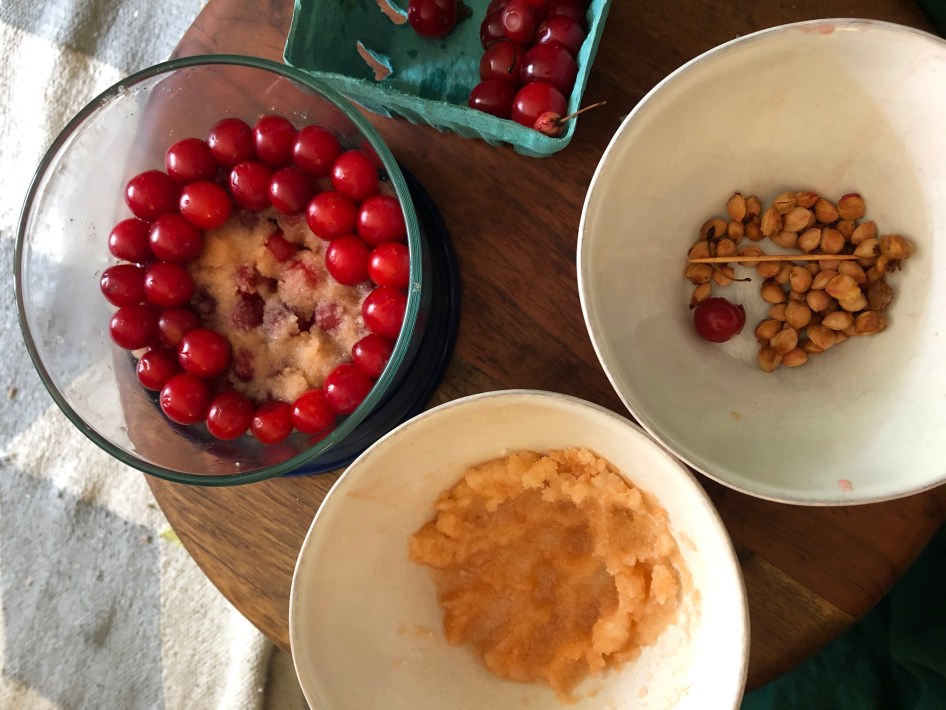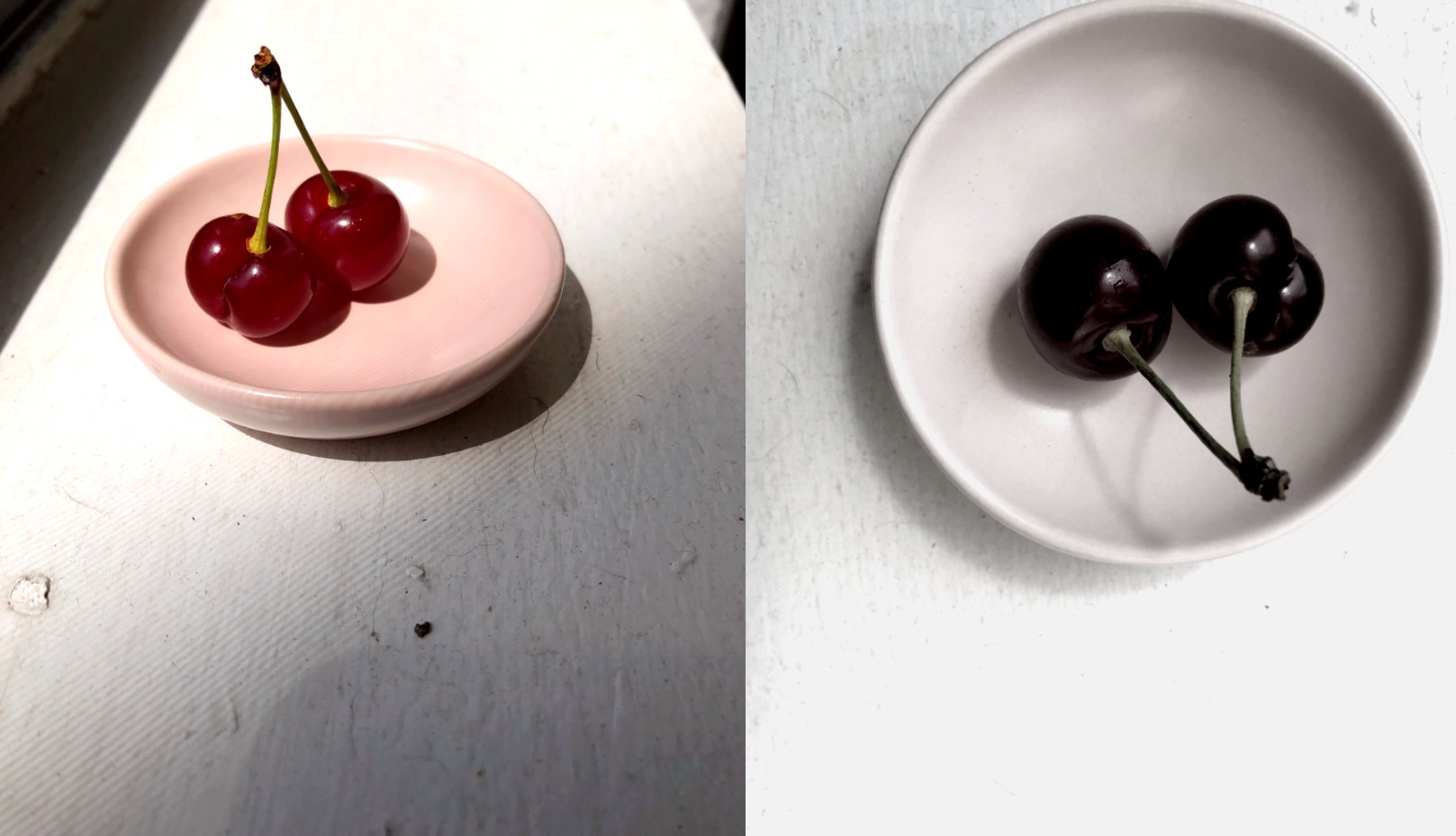Every year for the past four years, I’ve bought the summer cherries, gleaming and glistening in their blue cardboard boxes, snug and ripe to the point of bursting. They are sour. My teeth scrape the flesh from the pit, turn the cherry in my mouth, scrape again, my face puckers. It is warm and the morning at the farmers' market is bright, and every year the vendors ask if I want the sweet ones instead and I say, "No."
When I moved to Washington, D.C., from Central Texas, a whole world of tastes opened in front of me. I grew up on grocery store produce, on the mealy pale pink of a Wendy’s tomato that I plucked out from my hamburger and flung aside. I survived college on $2 bean and rice bowls and, in retrospect, not eating enough. I don’t remember the first great summer tomato I had that year, even though I remember it felt like the perfect gear shift: clean and seamless and yet somehow better. It was the same feeling I would have later that year when I stepped outside after a warm day to find the temperature had dropped after sunset, the revealing of a world I knew existed but hadn’t met.
The first great cherry I ate, though, I remember perfectly. I had begun going to the farmers' market every Sunday with $20. It was a luxury I couldn’t really afford on my $30,000 fellow salary, but I was depressed and already in some mild credit card debt from not having rich parents, and I needed the farmers' market.
There are very few things I love more than a market. Indoor or outdoor. I love to marvel at the spices, to ask questions about the greens, to accidentally buy a handful of beautiful flowers and gaze lovingly at them, cradle them in my arm like a newborn. What I love most about the market is it feels alive. Every sense is there. The peaches are fuzzy, the sunlight is warm or the wind is cold, it smells like bagels or cheese or coffee, everything is stacked up so the tops of fruits gleam and reflect while their bottoms cast dark shadows, everyone is in the mood to chat. It is Sunday morning.
That first cherry came from a farmer I bought arugula from every week. Arugula was trendy then, and the kind from the grocery store tasted like nothing, but the kind he gave me tasted like pepper. I did not have the money for the cherries, but I eyed them. I sized them up. Their skin was so taut, so deep red like a nail polish, their little stems were coming out of those fruit dimples and oh my god they were connected. I gasped.
“What?” he asked. I hadn’t known cherries actually did that. I had only seen them in cartoon versions in their little pairs, found them so cute I assumed they weren’t real. “Have you never had a cherry before?” he asked. I scoffed at him. Of course I had eaten cherries! I had tried to tie their stems in knots in middle school, spooned them with cold ice cream into my mouth at Braum's.
“No,” he said. “A real cherry.”
I ate the cherry he handed to me in the palm of his hand, so flat like it might fly away. My face puckered. "They’re like sour candy!" I yelled, thrilled. And he laughed at me, but he gave me a few in a baggie, and I ate them all on the walk back to my apartment. The next week, I bought the cherries first. I loved them.
But there was a slight problem. There were so many cherries in the boxes he gave me, and I am only one person. I devoured as many cherries as I could, and still there were cherries left. By the end of the week, my cherries would be falling off their adorable stems, starting to shrink, their skin no longer shimmering but shriveled.
I looked up what to do, but there isn’t really a good way to make fresh produce keep forever. You have to eat it. When cherry season ended, I was so sad, but that first winter, I survived by thinking about them. The sun would come back, and it would be warm again, and I would eat so many cherries that my stomach would hurt for days.
That year, my first winter, I was cold the whole time. I had to buy a new coat. It snowed before Thanksgiving. I was miserable, and all winter I waited for the cherries. I thought I would be fine, but I was not. My depression arrived darker and deeper than it had in Texas, but part of that was just bad luck. On one particularly bad night, we went out to dinner in our neighborhood and transferred money from our meager savings to buy fancy cocktails. I ordered a Manhattan that I remember perfectly, because I'm not sure I had tried many before that one. It came in a wide glass, and I was worried I would spill it. I kept my new coat on my shoulders because I was cold. At the bottom, there was a little cherry: not the same, but something. I would make it. I would wait until the cherries returned.
And the cherries did return. They were a little late that year. Something about rainfall or the snow, I didn’t understand. But I was so desperate for them that when they arrived, I bought two boxes immediately, and it was only when I got home with 300 small tart cherries that I realized that maybe this had not been a good idea. My cherries were going to go bad!! This was awful!!!!
I told a pal at the dog park about this problem the next afternoon. He is a chef and was by then used to my shenanigans. "Kelsey," he said calmly. "Just turn them into cocktail cherries." I nodded, but I didn't know how to do that. So he told me, and I went back to my little apartment beaming.
Now every year I sit on my floor with a toothpick, and I hold the tiny cherries gently. I stab through their skin, find the rough edge of the pit, and push it out the other side. I do this over and over again and my hands get sticky and my wrists get tired and after about an hour I have a tower of pitted cherries and a pile of pits. I have learned that cherry pits are poisonous and were once used by women in need of vengeance. But sadly my life isn’t that interesting, so I throw these away.

Then I make my silly little mix. I put some sugar in a bowl and I add to it: lemon juice, bourbon, cinnamon, cloves, and some Luxardo maraschino liqueur. The first year my friend Sam gave me some of his Luxardo liqueur, but the next year I got a new job that paid me a living wage, and I bought my own. This makes the sugar into basically a paste. If I add too much liquid, I put some more sugar in and mix it up. Then what I do is carefully place the cherries in a big Tupperware in a single layer, and spread my paste on them. I do this many many times. From the side of the Tupperware, you can see the layers like a cake.
Then I put the Tupperware on the top of my fridge for two days. After that, I take it down once a day and stir the cherries (carefully!) out of their beautiful rows and into the mushy paste, which becomes more and more liquid as the cherries release some of their juices. By the end of the third day of this mixing, the cherries are ready. I think you can do it for longer, but I’m not sure, because my friend told me what to do but then I forgot how to do it correctly and now it has been seven years so I just do it this way.
I sterilize some jars, gently spoon my cherries in there, add a little lemon peel and seal them up! (I always open this link and read it carefully, because I have a healthy fear of botulism.) Usually the cherries last about six weeks once opened, so it’s important to use small jars. Then I wait until winter when it is dark, and I pop one jar open and begin to plop my little luxurious cherries into my Manhattans. They taste more fermented than the fancy cherries you buy at the store, but that is fun to me. I eat them all winter, throwing the glass back when it’s empty to rocket the cherry into my mouth, crushing it between my teeth: tart, but sweet. It’s a small treat.
Winter is so much longer than I thought it was when I first moved here. I remember making a joke in December at my first job, saying in all seriousness, "Well, at least winter is almost over," thinking in full sincerity that winter ended in early February. Of course, it doesn't. If we're lucky, the cherry trees on the Tidal Basin bloom in April, and maybe winter is over then. Maybe it's not, because there are many kinds of winter: There is the darkness, and then there is the holidays, and then there is the brutal cold, and then there is the wet, lingering winter. We are still so far from spring.
The past few weeks, I've been reading this book by Katherine May called Wintering: The Power of Rest and Retreat in Difficult Times. It's a smart book about grief and weathering not only literal freezing winter, but winters of our emotional lives. "More than any other season," May writes, "winter requires a kind of metronome that ticks away its darkest beats, giving us a melody to follow into spring. The year will move on no matter what, but by paying attention to it, feeling its beat, and noticing the moments of transitions—perhaps even taking time to think about what we want from the next phase of the year—we can get the measure of it."
When I read this last week, I thought about my cherries. Every year, I wait as long as I can to pop open my first jar. Every year, for the darkest part of winter, they count down my weeks slowly and methodically. I waited almost until Thanksgiving to open my jar in 2020. But I never wait long enough.
This past year, getting the cherries was a whole ordeal. I had to make an appointment to go to the farmers' market on Opentable, and my farmer wasn’t there. I did find cherries and I went two weeks in a row to get them, but I didn’t get as many as I have in other years. Usually I make cherries every week for their whole season, and hand the jars off to my friends. But I haven't seen many friends lately. And I didn’t want to hog the cherries. Everyone deserved them.
It was still nice to pop the jar off of the cherries the first cold night, to pluck the cherries out of their created liquid and plop them into my cocktail. Sometimes I pour a little cherry juice in there to funk up my drink, too. It’s mundane, but it is cool to me.
No matter how many cherries I preserve, though, it is never enough.
Every winter, I look at the bobbing remaining cherries, reach for another jar, and there’s not one there. Every winter, I eat all the cherries and there is a long, empty stretch of months until the next ones arrive. One terrible year, it happened in January, but I’ve been careful to keep an eye on the cherry stock since then. On Saturday night, I went to put a cherry in a Manhattan, and I realized there weren't so many left. More than 10, but less than 20. This year, we will run out in February.
I cried later that night about a few things, but mainly I was crying because ever since last March it feels like I am always on the verge of tears, always one shattered wine glass or text with bad news from breaking. It is so hard to keep on living when you are tired and the whole world seems bad and your brain is against you. It is so hard to go to therapy and take your pills and wake up in darkness and decide to keep going. But we do it. We are doing it together.
"If happiness is a skill, then sadness is, too," May writes, "...that is wintering. It is the active acceptance of sadness. It is the practice of allowing ourselves to feel it as a need. It is courage to stare down the worst parts of our experience and commit to healing them the best we can. Wintering is a moment of intuition, our true needs felt as keenly as a knife."
One of the hardest things about this pandemic, for me personally, has been the lack of things to look forward to. I'm a planner. I like to map out a bunch of things for the future, and count down the days until they arrive. I like to look forward in the middle of winter and remember that something good will happen in the future that I want to be here for. It is hard to look out into a future full of fog and death and fear. It is hard to look at a future where even spots that should be bright are masked by the knowledge that they will be different in concrete, upsetting ways. We are all grieving right now, and so our winters are not unique. We are grieving hundreds of thousands of people dead, loved ones not seen, life events cancelled or postponed, dreams morphed beyond recognition, terrors that don't go away at daybreak. We are sad. Or at least I am sad, and I am trying to be more okay with that, to welcome the sadness at times instead of pushing it too far away.
This week, I am looking at photos of the cherries on my phone and reminding myself that summer will come again, that the farmers will return with cherries for me, picked and gleaming, and that I will try not to cry with happiness upon seeing them. Even if the cherries come and the pandemic is not over and our metaphorical winter continues a little longer, we can manage it. At least this year, I will buy and jar way too many cherries. This winter will end. They all do. The cherries will come.







